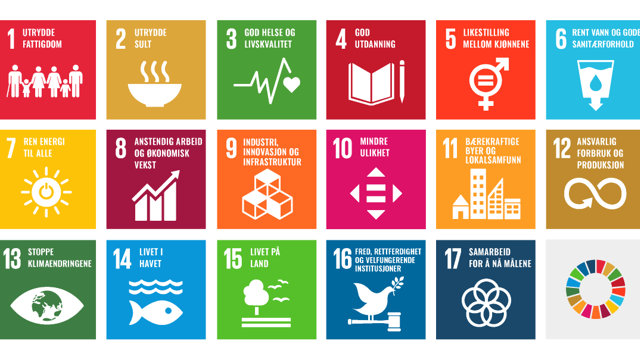The sustainability goals

The UN's 17 sustainability goals will guide Norwegian development policy until 2030.
Extreme poverty must be eradicated. Social inequalities must be equalised. Climate change must be slowed down.
The UN's member states have adopted 17 common global goals for sustainable development over the next 15 years.
The new sustainability goals see environment, economy and social development in context.
- Read more about the sustainability agenda
Replaces the Millennium Development Goals
The sustainability goals replace the Millennium Development Goals that were adopted in 2000.
The Millennium Development Goals have been a success. They have mobilized for joint efforts against poverty and for development.
Extreme poverty has been halved. Nine out of ten children now go to school. Millions of malaria and HIV/AIDS-related deaths have been averted.
Several of the Millennium Development Goals have been continued in the sustainability goals.
New development features
The breadth of sustainability goals reflects the changes the world community has undergone since 2000.
The power relationship between north and south, and east and west is different.
The north and west have experienced financial crises. In the south and east there has been positive economic development. At the same time, the world is going through challenges related to climate change, increasing inequality and social unrest.
All these dimensions of sustainable development are included in the sustainability goals: environment, economy and social development. In this way, the new sustainability agenda addresses the causes of poverty to a greater extent than the Millennium Development Goals did.
It will be important to strengthen public institutions, good governance and stability. These are fundamental structures for poverty reduction and sustainable development, especially in vulnerable communities.
The new agenda confirms that there is still a need for a high level of aid. At the same time, it recognizes that it is also necessary to utilize other and larger capital flows.
According to the World Bank's analyses, we must go from talking about billions to talking trillions (English trillions) if the world is to be able to finance the new goals.
Financing for development
In Addis Ababa, Ethiopia, the third conference on financing for development was held in July 2015. There, a framework for financing sustainable development was agreed. The document supports the new sustainability goals.
Better political and economic conditions nationally and internationally are essential for success, the document states. It shows that, among other things, greater emphasis must be placed on equality in order to strengthen a country's economic growth.
- Read the Financing for Development document from Addis Ababa
The Financing for Development conference also put forward some key measures to get enough funds for the work.
More tax through reliable tax systems, stopping illegal capital flight and fighting corruption are highlighted.
"Tax for development" is one example of Norwegian aid that contributes to this.
Applies to all countries
The goals are not just a plan for the developing countries. They are based on domestic political conditions in all countries.
The new agenda is clear about the framework conditions that must be the basis for this work to be successful.
It points out that democracy, good governance and a legal culture are essential for sustainable development. The goals aim to realize human rights for all.
The message is that no one should be left behind: No one will be left behind.
Democratic process
All of the UN's 193 countries have been allowed to participate in the design of the sustainability goals.
The Millennium Development Goals were drawn up by employees of the UN system, based on already agreed commitments. In contrast, the sustainability goals have come about through intergovernmental negotiations.
Civil society organizations and private business have also contributed.
Worldwide poll
UN Secretary-General Ban Ki-moon wanted the sustainability agenda towards 2030 to be the world's most inclusive development process. The My Word survey is an example of this.
My World was a worldwide survey that was carried out before the formulation of the sustainability goals. The survey collected a lot of data on the kinds of problems that preoccupy people globally. The survey has been carried out both online and via offline channels via the UN.
The results of the My World survey are freely available. An interactive statistics portal provides the answers from over eight million people. The results show that much is similar between the countries. The differences are small between men and women.
Education is repeated in the survey as the theme most people highlight as the most important for themselves and their own family.
The answers from the survey had a direct impact on the design of the sustainability goals at the highest level.
Climate focus
Through the new agenda, the world has set itself the goal of taking climate and environmental considerations into account. This includes industry, agriculture, cities and energy.
During the COP21 climate summit in Paris in 2015, all the world's countries agreed to keep the global temperature increase well below 2 degrees compared to pre-industrial levels, and strive to keep the temperature increase below 1.5 degrees.